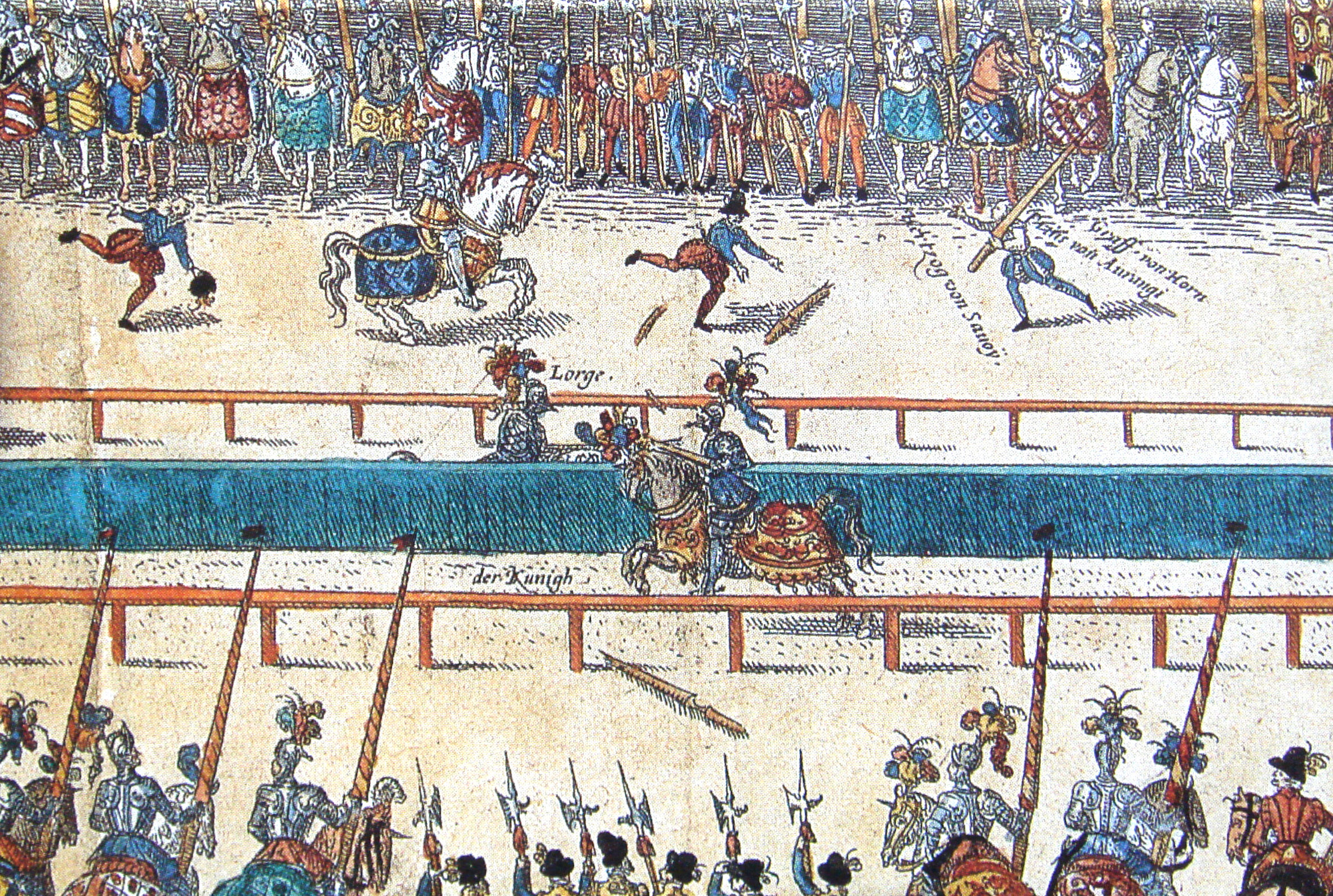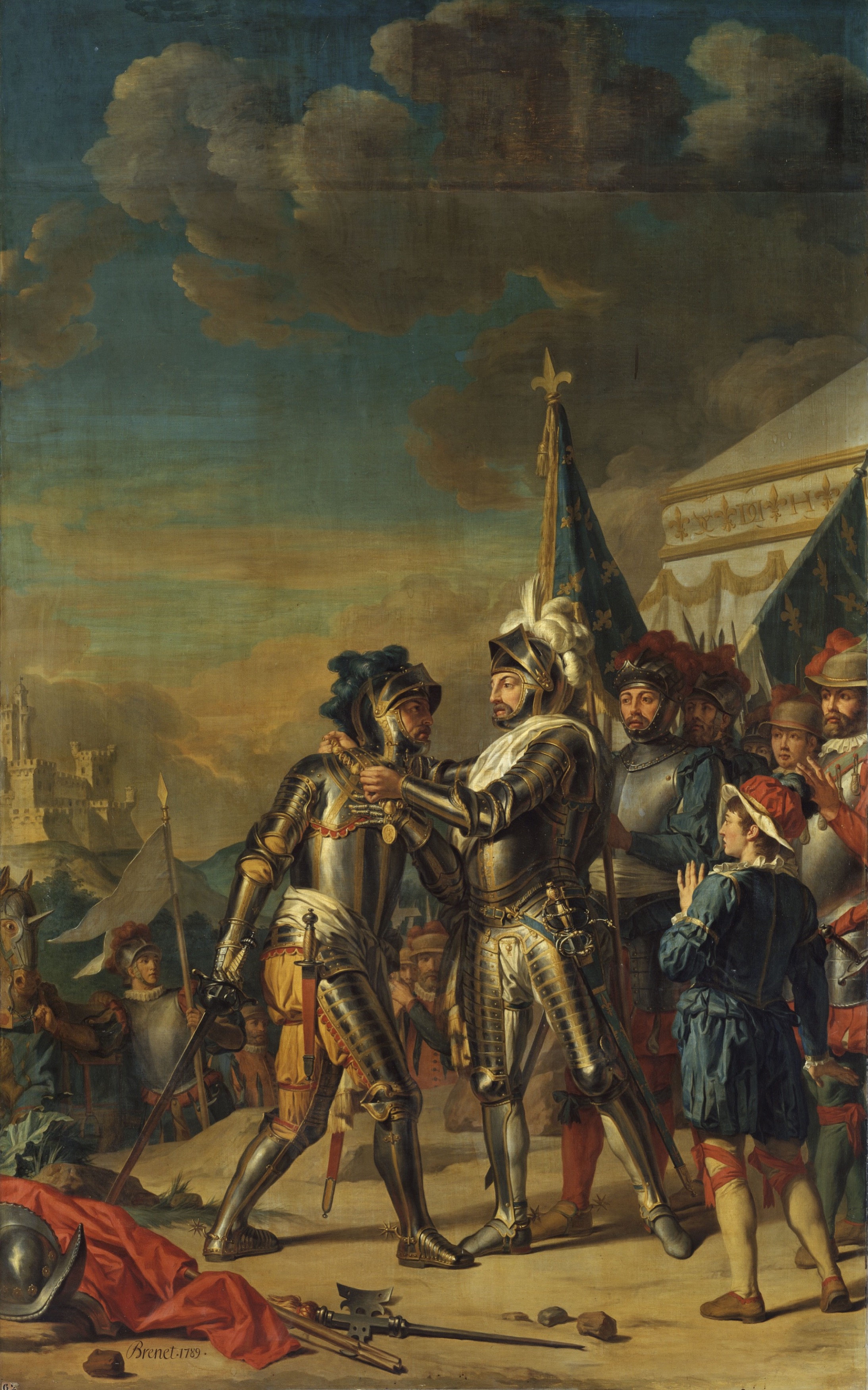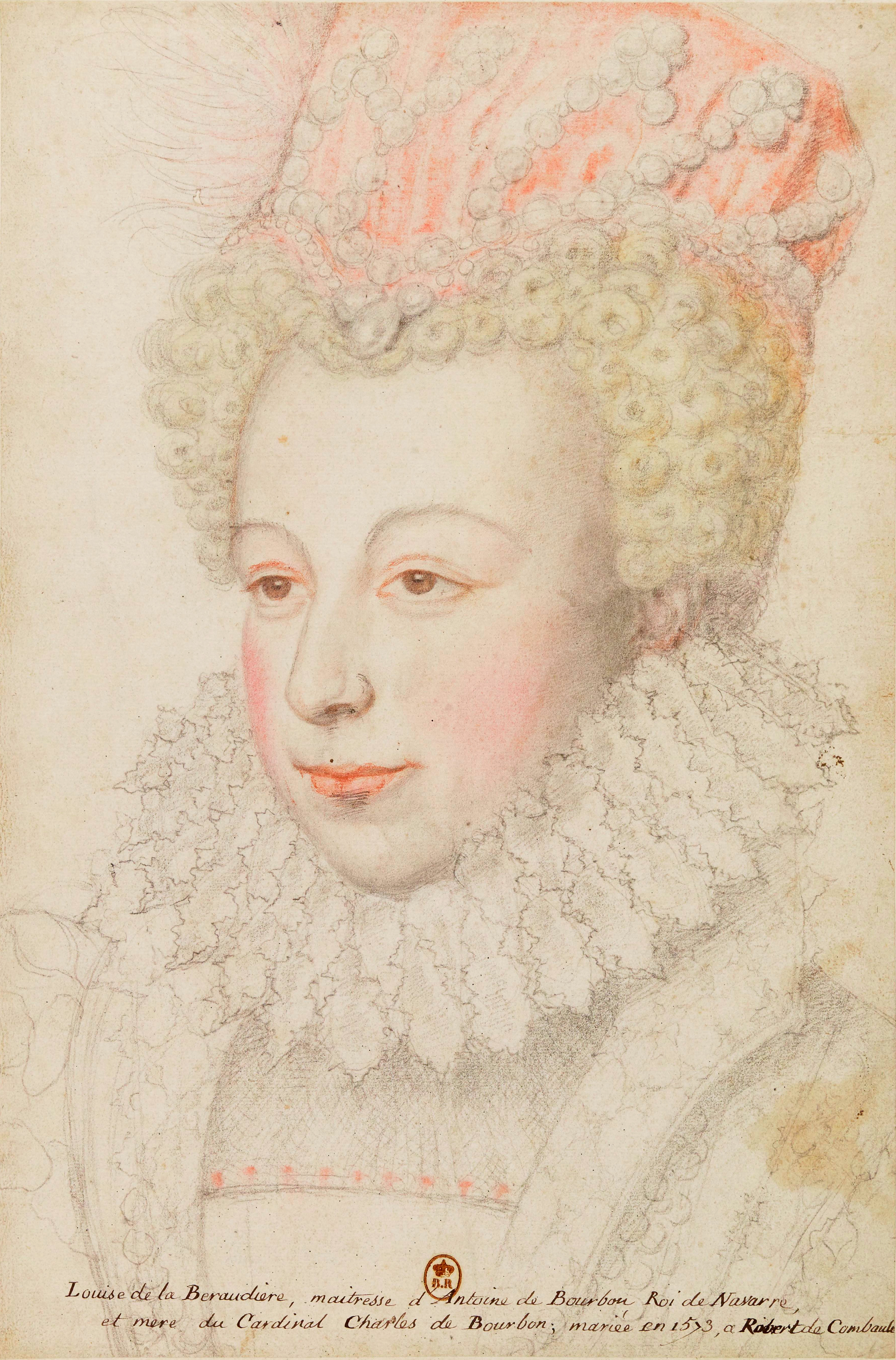|
Peace Of Saint-Germain-en-Laye
The Peace of Saint-Germain-en-Laye was signed on 8 August 1570 by Charles IX of France, Gaspard II de Coligny and Jeanne d'Albret, and ended the 1568 to 1570 Third Civil War, part of the French Wars of Religion. The Peace went much further than the March 1568 Peace of Longjumeau by establishing specific rights and responsibilities for French Protestants, generally known as Huguenots. Freedom of worship was permitted in two towns per ''gouvernment'', while the Huguenots were allowed to maintain armed garrisons in four surety towns for a period of two years, after which they had to be returned to Royal control. However, the civil war resumed in 1572 after the targeted assassination of Huguenot leaders assembled in Paris, spiralled into the St. Bartholomew's Day massacre. The Third Civil War Following the outbreak of civil war in 1568, the Huguenots under Coligny and Condé opted to defend the south-west by fortifying towns such as Angoulême and Cognac. As they moved south i ... [...More Info...] [...Related Items...] OR: [Wikipedia] [Google] [Baidu] |
Saint-Germain-en-Laye
Saint-Germain-en-Laye () is a commune in the Yvelines department in the Île-de-France in north-central France. It is located in the western suburbs of Paris, from the centre of Paris. Inhabitants are called ''Saint-Germanois'' or ''Saint-Germinois''. With its elegant tree-lined streets it is one of the more affluent suburbs of Paris, combining both high-end leisure spots and exclusive residential neighborhoods (see the Golden Triangle of the Yvelines). Saint-Germain-en-Laye is a sub-prefecture of the department. Because it includes the National Forest of Saint-Germain-en-Laye, it covers approximately , making it the largest commune in the Yvelines. It occupies a large loop of the Seine. Saint-Germain-en-Laye lies at one of the western termini of Line A of the RER. History Saint-Germain-en-Laye was founded in 1020 when King Robert the Pious (ruled 996–1031) founded a convent on the site of the present Church of Saint-Germain. In 1688, James II of England exiled hi ... [...More Info...] [...Related Items...] OR: [Wikipedia] [Google] [Baidu] |
Henri, Prince Of Condé (1552–1588)
Henri I de Bourbon, Prince of Condé (29 December 1552 – 5 March 1588) was a French Prince du Sang and Huguenot general like his more prominent father, Louis I, Prince of Condé. Life Henri was the eldest son of Louis I de Bourbon and Eléanor de Roye, daughter and heiress of Charles de Roye, Count of Roucy. Of the eight children in his family, he and his brother François, Prince of Conti, were the only ones to have children. Following the death of his father, Louis, at the Battle of Jarnac, Jeanne d'Albret introduced Henri and her own son, Henry of Navarre, as pages to Admiral Coligny. Since both were ''princes of the blood'', this act gave the Huguenot cause legitimacy. At the Battle of Moncontour on 3 October 1569, Henri was wounded in the face and was forced to retreat. Attending the wedding of Henry of Navarre and the subsequent massacre of Protestants, Henri was forced to convert to Catholicism, face death or life imprisonment. In his escape from Paris, Henri was jo ... [...More Info...] [...Related Items...] OR: [Wikipedia] [Google] [Baidu] |
Toulouse
Toulouse ( , ; oc, Tolosa ) is the prefecture of the French department of Haute-Garonne and of the larger region of Occitania. The city is on the banks of the River Garonne, from the Mediterranean Sea, from the Atlantic Ocean and from Paris. It is the fourth-largest city in France after Paris, Marseille and Lyon, with 493,465 inhabitants within its municipal boundaries (2019 census); its metropolitan area has a population of 1,454,158 inhabitants (2019 census). Toulouse is the central city of one of the 20 French Métropoles, with one of the three strongest demographic growth (2013-2019). Toulouse is the centre of the European aerospace industry, with the headquarters of Airbus, the SPOT satellite system, ATR and the Aerospace Valley. It hosts the CNES's Toulouse Space Centre (CST) which is the largest national space centre in Europe, but also, on the military side, the newly created NATO space centre of excellence and the French Space Command and Space Academy. Thales ... [...More Info...] [...Related Items...] OR: [Wikipedia] [Google] [Baidu] |
Gabriel De Lorges, Count Of Montgomery
Gabriel de Lorges, Count of Montgomery, Lord of Lorges and Ducey (5 May 153026 June 1574), was a French nobleman of Scottish extraction and captain of the Scots Guard of King Henry II of France. He is remembered for mortally injuring Henry II in a jousting accident and subsequently converting to Protestantism, the faith that the Scots Guard sought to suppress. He became a leader of the Huguenots. In French-language contexts, his name is spelled Montgommery. Career On 30 June 1559, during a jousting match to celebrate the Peace of Cateau Cambrésis between Henry II and his longtime Habsburg enemies, and two major marriages, namely that of Marguerite, the king's sister, with the Duke of Savoy Emmanuel-Philibert, and that of Elisabeth, the king's eldest daughter, with Philip II, king of Spain, a splinter of wood from Montgomery's shattered lance pierced Henry's eye and entered his brain, fatally injuring him. From his deathbed Henry absolved Montgomery of any blame, before dying on ... [...More Info...] [...Related Items...] OR: [Wikipedia] [Google] [Baidu] |
Languedoc
The Province of Languedoc (; , ; oc, Lengadòc ) is a former province of France. Most of its territory is now contained in the modern-day region of Occitanie in Southern France. Its capital city was Toulouse. It had an area of approximately 42,700 square kilometers (16,490 square miles). History The Roman province of Gallia Narbonensis fell to the Visigothic Kingdom from the 5th to the 8th centuries. Occupied briefly by the Emirate of Córdoba between 719 and 759, it was conquered and incorporated into the Kingdom of the Franks by Pippin the Short in 759 following the Siege of Narbonne. Under the Carolingians, the counts of Toulouse were appointed by the royal court. Later, this office became hereditary. Part of the territory where Occitan was spoken came to be called ''langue d'oc'', ''Lengadòc'' or Languedoc. In the 13th century, the spiritual beliefs of the area were challenged by the See of Rome and the region became attached to the Kingdom of France following the ... [...More Info...] [...Related Items...] OR: [Wikipedia] [Google] [Baidu] |
Saint-Jean-d'Angély
Saint-Jean-d'Angély (; Saintongeais: ''Sént-Jhan-d'Anjhéli'') is a commune in the Charente-Maritime department in southwestern France. The commune has its historical origins in the Abbey of Saint-Jean-d'Angély. Royal abbey Founded in the ninth century to house a relic of Saint John the Baptist, and rebuilt in the 14th, 17th and 18th centuries because of repeated destruction, then later abandoned, the Abbey is now a listed building. It remains the most remarkable piece of architecture of Saint-Jean-d'Angély, a town which has kept all its medieval charm. Situated on the pilgrim route that led to Santiago de CompostelaThe route is registered by the UNESCO as part of the "World Heritage of Humanity" the edifice still constitutes a major stopping-off point towards Santiago de Compostela. Since 1989, the Royal Abbey has housed the Centre of European Culture, which has breathed new life into the Abbey by restoring it as a historical and cultural site and as a place for the exch ... [...More Info...] [...Related Items...] OR: [Wikipedia] [Google] [Baidu] |
Battle Of Moncontour
The Battle of Moncontour occurred on 3 October 1569 between the Royalist Catholic forces of King Charles IX of France, commanded by Henry, Duke of Anjou, and the Huguenots commanded by Gaspard de Coligny. The battle Weeks before, Coligny had lifted the siege of Poitou and positioned his army in hopes of gaining an advantage over the approaching Royalist forces. However, a flanking manoeuvre by Salx-Tavannes along the River Dive forced him from this position. This coincided with Henry's objective to keep Coligny's army from joining Gabriel, Comte de Montgomery's forces operating in the South of the country. Coligny attempted to rectify the situation by moving to a better location across the River Thouet. But he was delayed by a strike by his German mercenaries, who demanded their pay before moving. By the time he was able to get underway, the Royalist army had formed a line of battle and were advancing on his flank. With no choice now but to fight, Coligny formed up to meet them. ... [...More Info...] [...Related Items...] OR: [Wikipedia] [Google] [Baidu] |
Châtellerault
Châtellerault (; Poitevin-Saintongeais: ''Châteulrô/Chateleràud''; oc, Chastelairaud) is a commune in the Vienne department in the Nouvelle-Aquitaine region in France. It is located in the northeast of the former province Poitou, and the residents are called ''Châtelleraudais''. Geography Châtellerault lies on the river Vienne, a few km downstream from its confluence with the Clain in Cenon-sur-Vienne. History Châtellerault was an important stronghold on the northern march of Poitou, established by the Count of Poitiers to secure his borders in the early 10th century. The count's local representative, the Vicomte de Châtellerault was established as a hereditary appointment by the time of Airaud who was probably a kinsman of the counts of Auvergne and dukes of Aquitaine; his heirs were ''vicomtes'' (viscounts) until the mid-11th century. The daughter of Aymeric I, Ænor of Châtellerault (c. 1103 – c. 1130), whose mother had been the "mistress" in the new courtly ... [...More Info...] [...Related Items...] OR: [Wikipedia] [Google] [Baidu] |
Gaspard De Saulx
Gaspard de Saulx, sieur de Tavannes (March 1509–June 1573) was a French Roman Catholic military leader during the Italian Wars and the French Wars of Religion. He served under four kings during his career, participating in the Siege of Calais (1558) and leading the royal army to victory in the third civil war at the Jarnac and Moncontour. A strong Catholic, he founded the confraternity of the holy ghost in 1567 which would be a template for other militant Catholic organisations across France. He died in 1573, shortly after the opening assassinations of the Massacre of Saint Bartholomew, which he had helped plan. Early life and family The Saulx family was well established in Dijon, Gaspard's great-grandfather having been a judge in the Paris ''Parlement'' and a councillor to the Duke of Burgundy. Gaspard was born in 1509 in the house Jean de Saulx had commissioned in 1412. He was the son of Jean de Saulx, baron of Sully, and od Marguerite de Tavannes, their second child of three. ... [...More Info...] [...Related Items...] OR: [Wikipedia] [Google] [Baidu] |
Henry I, Duke Of Guise
Henry I, Prince of Joinville, Duke of Guise, Count of Eu (31 December 1550 – 23 December 1588), sometimes called ('Scarface'), was the eldest son of Francis, Duke of Guise, and Anna d'Este. His maternal grandparents were Ercole II d'Este, Duke of Ferrara, and Renée of France. Through his maternal grandfather, he was a descendant of Lucrezia Borgia and Pope Alexander VI. A key figure in the French Wars of Religion, he was one of the namesakes of the War of the Three Henrys. A powerful opponent of the queen mother, Catherine de' Medici, Henry was assassinated by the bodyguards of her son, King Henry III. Early life Henry was born on 31 December 1550, the eldest son of Francis Duke of Guise, one of the leading magnates of France, and Anna d'Este, daughter of the Duke of Ferrara. In his youth he was friends with Henry III, the future king, and at the behest of Jacques, Duke of Nemours tried to persuade the young prince to run away with him in 1561 to join the arch-Catholic ... [...More Info...] [...Related Items...] OR: [Wikipedia] [Google] [Baidu] |
Poitiers
Poitiers (, , , ; Poitevin: ''Poetàe'') is a city on the River Clain in west-central France. It is a commune and the capital of the Vienne department and the historical centre of Poitou. In 2017 it had a population of 88,291. Its agglomeration has 130,853 inhabitants in 2016 and is the center of an urban area of 261,795 inhabitants. With more than 29,000 students, Poitiers has been a major university city since the creation of its university in 1431, having hosted René Descartes, Joachim du Bellay and François Rabelais, among others. A city of art and history, still known as "''Ville aux cent clochers''" the centre of town is picturesque and its streets include predominantly historical architecture and half-timbered houses, especially religious architecture, mostly from the Romanesque period ; including notably the Saint-Jean baptistery (4th century), the hypogeum of the Dunes (7th century), the Notre-Dame-la-Grande church (12th century), the Saint-Porchaire church (12th ... [...More Info...] [...Related Items...] OR: [Wikipedia] [Google] [Baidu] |
Battle Of La Roche-l'Abeille
The Battle of La Roche-l'Abeille occurred on 25 June 1569 between the Catholic forces of King Charles IX of France commanded by the Duke d’Anjou and the Huguenots commanded by the Admiral de Coligny during the "Third War" (1568–1570) of the French Wars of Religion. Background The Third War of Religion saw an uprising of the Protestants and the creation of an army under the command of Louis I de Bourbon, prince de Condé. This army had laid siege to several cities in the Poitou region, and then Angoulême and Cognac. At the Battle of Jarnac (16 March 1569), the Prince de Condé was killed, forcing Admiral de Coligny to take command. In order to attack the royal army, Coligny directed the Protestant army toward the Limousin region, hoping thus to regroup with 14,000 mercenaries being led by the Duke of Zweibrücken (french: duc des Deux-Ponts) and financed by Queen Elizabeth I of England. After a brief fight with a detachment of the royal army, the Duke of Zweibrücken was ... [...More Info...] [...Related Items...] OR: [Wikipedia] [Google] [Baidu] |





